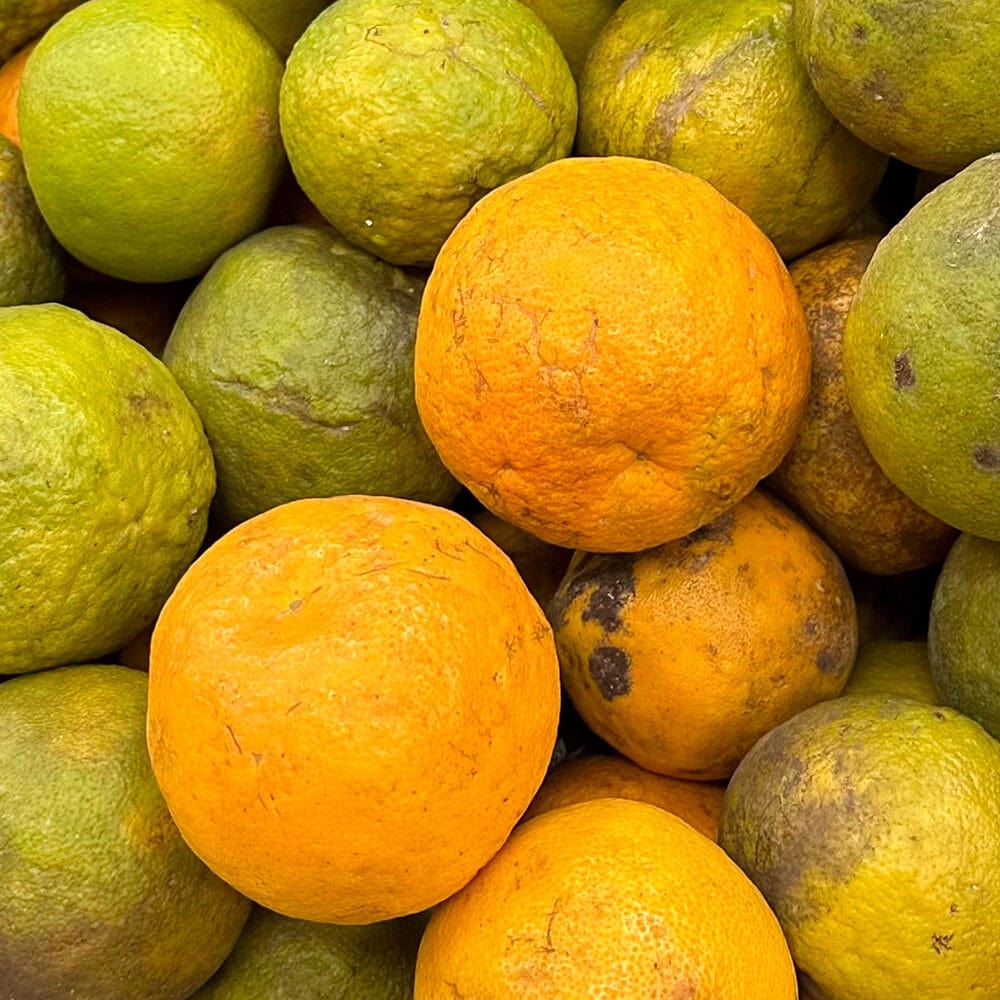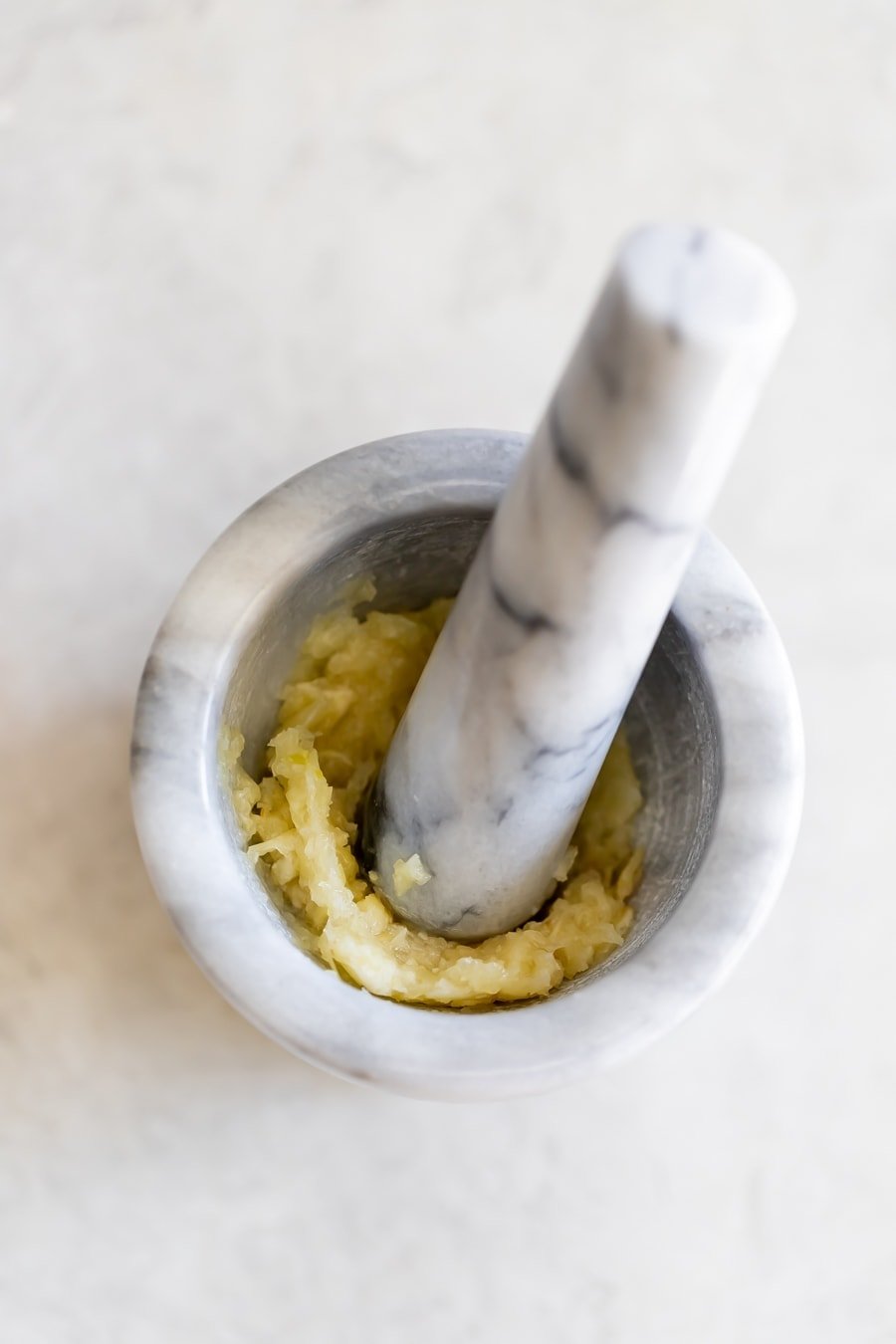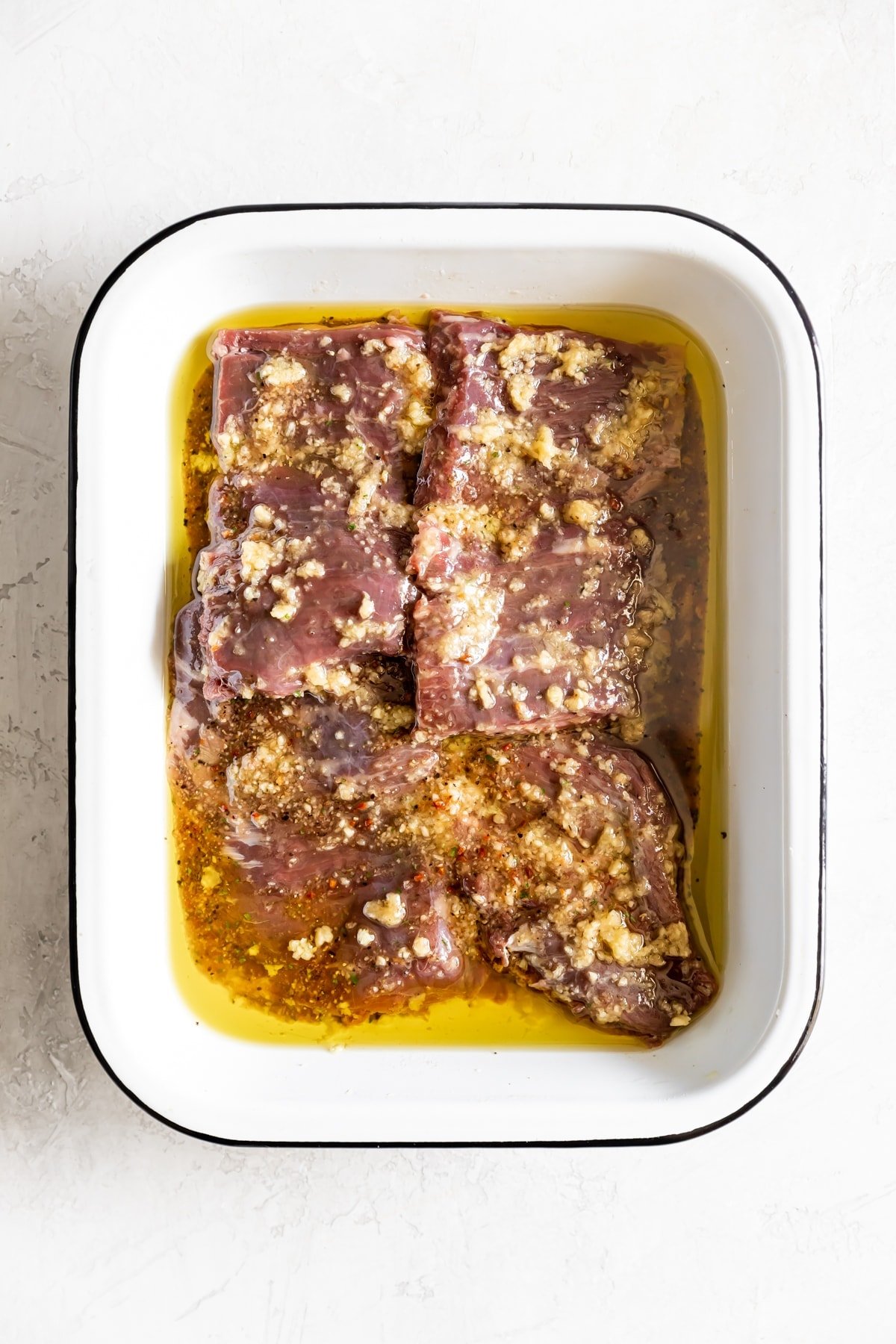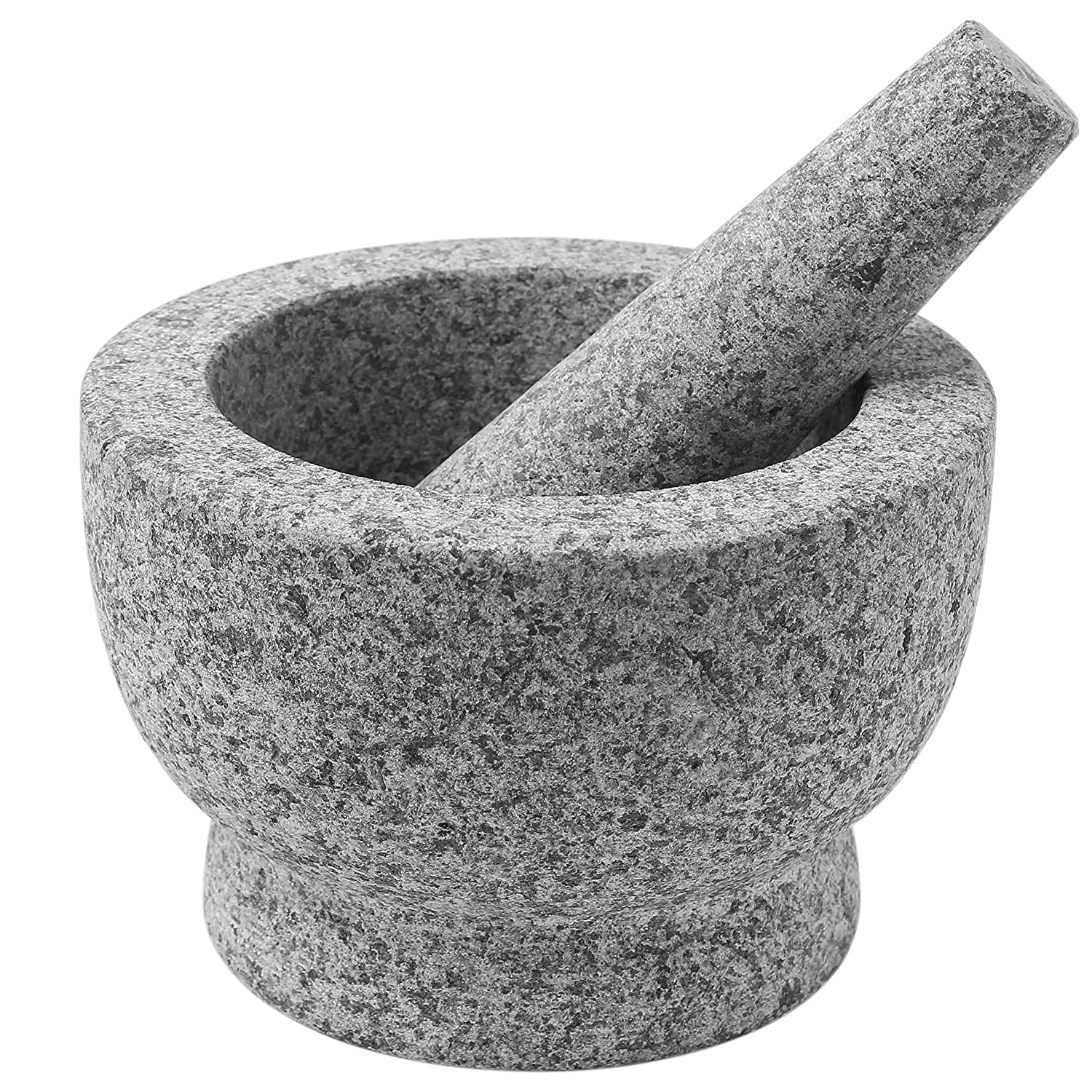Welcome to the best marinade you’ll ever make! Growing up in a Cuban family, you basically marinate EVERYTHING with mojo criollo. From pollo a la plancha to lechon asado and palomilla steak, this tangy garlic-citrus marinade infuses meats with a burst of tangy goodness, perfect for grilling, roasting, and pan-frying.
I’ve been enjoying mojo criollo since birth and I have to say, I never get tired of it. Maybe I’m biased.
Mojo marinade (or mojo criollo), pronounced moh-hoh, is a Cuban citrusy, garlicky marinade that has a slightly sour flavor. I’ve seen several variations of this marinade but an authentic Cuban mojo is simple, versatile, and only has 7 simple ingredients that I’m pretty sure are in your pantry right now.
Let me show you how to make it!

Ingredients You’ll Need
- Garlic. An authentic Cuban mojo starts with a head of garlic. Yes, we’re talking about 8-10 garlic cloves, depending on their size. I know it sounds like a lot but this is the star of the show. Garlic SHINES in this recipe. If you’re not a fan (why?), you can add less garlic (maybe 5 or 6 cloves). Just know it will not taste as authentic.
- Citrus. Another star ingredient in Cuban mojo is sour orange. Naranja agria (or bitter orange or sour orange) is a citrus fruit used a lot in Caribbean cooking that has a tart, tangy, sour flavor. More on that in a minute.
- Oregano. While some recipes may include fresh oregano leaves and cilantro, authentic Cuban mojo marinade typically omits cumin and cilantro. For a more traditional flavor, I recommend using dry oregano, as it complements the other ingredients without overpowering them.
- Oil. This is the base of the marinade and it plays an integral part in keeping the protein you use for this marinade from drying out.
5 star review
“This recipe was a lifesaver for me. Have been using the Goya brand for years. Recently moved to Valencia, Spain and thought it would be easy to find. Lots of Goya products here, but not this one. So, I made my own version of yours and actually like it even better. Maybe because I doubled up on the garlic :)”
—Gary
Let’s Talk Sour Oranges
Sour oranges have an orange bumpy-like skin and are pale orange inside. You need approximately 4-6 sour oranges for 1 1/2 cups of fresh sour orange juice, depending on their size and juiciness.

I know sour oranges can be hard to find so if you can’t find them, you can buy storebought sour orange juice (this is the brand I recommend) or make your own with navel oranges. While navel oranges lack that intense tart flavor, they still provide a bright and citrusy flavor that works well in a traditional bitter orange marinade, like mojo criollo.
To make fresh sour orange juice, stir the following juiced citrus together until well combined:
- 1 cup fresh navel orange juice
- 1/4 cup fresh lemon juice
- 1/4 cup fresh lime juice


Instructions
Make a garlic paste. In a mortar and pestle, add the garlic cloves with 1/4 teaspoon of salt. Mash the garlic cloves until you get a smooth paste. The salt helps break down the garlic.
Make sour orange juice. If you have sour orange juice, skip this step. Use two parts orange to one part lemon and one part lime. Start by juicing the navel oranges, lemons, and limes. You need 1 cup fresh navel orange juice, 1/4 cup fresh lemon juice, and 1/4 cup fresh lime juice. Stir the juices together until well combined.
Make the marinade. In a large jar with a lid, add the garlic paste, onions, sour orange juice, oregano, oil, and salt & pepper. Start with 1/2 teaspoon of salt and 1/4 teaspoon of black pepper. Close the jar tightly and shake it until well combined.
Taste and adjust salt as needed. This marinade should taste garlicky, citrusy, bright, tangy, and slightly sour. Be sure to shake well before every use.
Recommended For This Recipe
Mortar and Pestle
This age-old, traditional manual grinding method ensures that all cooking ingredients bring out their full flavor and aroma profiles!
Marinating Times
How long to marinate with mojo will vary depending on the type of protein and the recipe. Marinating proteins for too long with citrus can actually backfire. Tenderizing meat for too long can break down the proteins too much, leaving your meat kinda mushy.
Pork
If you’re making Cuban roast pork, you should marinate it for about 4 hours up to overnight. This allows for the marinade to break down the meat so it’s more tender and flavorful. Pork shoulder or Pork butt is tougher so the longer you can marinate, the better.
Pork chops and pork tenderloin need less time for marinating, about 2 hours but no more than 4 hours, because they are relatively lean and tender.
Chicken
If you’re marinating chicken thighs or drumsticks, aim for 2-6 hours because they are juicier and can handle longer marinating time.
Chicken breasts and chicken wings, on the other hand, are leaner cuts so they don’t need as much marinating time. Aim for 1-3 hours max.
Beef
Depending on the cut of meat, I’d recommend at least 1 hour but no more than 4 hours.
- Tender cuts, such as ribeye or tenderloin, should marinade for 1-2 hours.
- Denser cuts, like sirloin or strip steak, should marinate for 2-3 hours.
- Tougher cuts, like flank steak or skirt, require longer marinating times to break down the connective tissue. For example, churrasco, which is skirt steak, should marinate for no more than 4 hours or the texture will change.
Seafood
When it comes to marinating seafood, the marinating times are relatively short.
- Shrimp, for example, is more delicate so it shouldn’t marinate for more than 30 minutes or it will get mushy. Unless you’re making a shrimp ceviche which is marinated with citrus alone.
- The same goes for salmon, scallops, and fish fillets — they absorb flavors quickly so they don’t need long marinating times. Aim for 15-30 minutes depending on the thickness of the seafood.
*IMPORTANT* — Remember to immediately discard any marinade that was used to marinate raw meat to avoid consuming potentially harmful bacteria. If you have any leftover marinade that hasn’t been used with raw meat, you can safely store it in an airtight container in the fridge to use it for other dishes.
Recipe Tips & Tricks
Make-Ahead Tips. Whip up a batch of this mojo marinade ahead of time and store it in an airtight container in the refrigerator for up to 1 week. This way you have mojo ready to go whenever you need it!
Scale the recipe! For every pound of meat, you need about 1/2 cup of marinade. If you’re marinating more than 3 lbs of meat, you can double this recipe easily to make 3 cups (and save the rest).
Storage Tips. This fresh marinade lasts about 1 week in the fridge when stored properly in an airtight container. You can also freeze leftover, unused marinade for up to 3 months.

Authentic Cuban Mojo Criollo (Mojo Marinade)
Ingredients
- 1 head garlic 8-10 large cloves
- 1 1/2 cups sour orange juice* (naranja agria)
- 1/3 cup minced white onion
- 1 teaspoon dried oregano
- 1/3 cup neutral oil
- Salt and pepper to taste
Instructions
- Make a garlic paste. Add the garlic cloves with 1/4 teaspoon of salt in a mortar and pestle. Mash the garlic cloves until you get a smooth paste. The salt helps break down the garlic.
- Make sour orange juice. If you have sour orange juice, skip this step. Use two parts orange to one part lemon and one part lime. Start by juicing the navel oranges, lemons, and limes. You need 1 cup fresh navel orange juice, 1/4 cup fresh lemon juice, and 1/4 cup fresh lime juice. Stir the juices together until well combined.
- Make the marinade. Add the garlic paste, onions, sour orange juice, oregano, oil, and salt & pepper in a large jar with a lid. Start with 1/2 teaspoon of salt and 1/4 teaspoon of black pepper. Close the jar tightly and shake it until well combined.
- Taste and adjust salt as needed. This marinade should taste garlicky, citrusy, bright, tangy, and slightly sour. Be sure to shake well before every use. Enjoy!










KIM says
I made this and added just a tiny pinch of red pepper flake for a little hear.
The flavor balance was so good that I saved a little out to make a marinated vegetable salad. It was divine!
Mercelena Vasquez-Funk says
Hello,
How long do you marinate shrimp. I was just gifted some blood oranges and I can’t wait to make your recipe.
Jamie Silva says
As I mentioned in the blog post, you can marinate seafood from 10-30 minutes. I do not recommend longer than 30 minutes.
Gerry Guerra says
Question: If I can’t find sour oranges can white vinegar be used as a substitute?
Jamie Silva says
Hi! As I mentioned in the blog post, if you can’t find sour oranges nor sour orange juice, you can make your own using 1 cup of freshly squeezed orange juice from 3 navel oranges + 1/2 cup fresh lemon juice from 3 lemons + 1/2 cup fresh lime juice from 4 limes.
Pattie Stokes says
What are the measurements for the rub you put on the pork prior to the marinade?
Jamie Silva says
Hi Pattie, you can find the full recipe here: https://asassyspoon.com/cuban-roast-pork-lechon-asado/
Don says
I do love this marinade and have gotten a lot of compliments on it.
I use a very similar recipe with my own touches that you may not approve of or like but I enjoy them.
I like a touch of heat so a pinch of red pepper flakes and some fresh chopped/mince mint adds some nice flavor to the party as well.
Julie says
I made it to use in my homemade beef jerky recipe.
It is the base liquid and I add liquid smoke and a bit of dale’s….I’m now into making Beef Biltong similar to jerky, but a lot thinner, almost shaved.
Thanks for sharing this!
Kandace pogue says
Silly easy thank you, And it’s tasty good! I marinated chicken breasts for the grill! Real good!
Gary says
This recipe was a lifesaver for me. Have been using the Goya brand for years. Recently moved to Valencia, Spain and thought it would be easy to find. Lots of Goya products here, but not this one. So, I made my own version of yours and actually like it even better. Maybe because I doubled up on the garlic :)
Looking forward to exploring the site for more inspiration.
Cheers!
Jamie Silva says
The comment made my day, Gary! Thank you for sharing!
Bianca says
Love this recipe! I’ve made it a few times. Once buying the sour orange juice and a few times with oranges, lemons, and limes. Both ways are delicious. Thanks for sharing!!
Carol Tribuzio says
Love the spices and recipes
Maylin says
The best
Thanks
Jane Monti says
We got busy and did not cook the pork tenderloin with your marinade the first night, but did so last night. It is terrific, moist, tender, flavorful. You are right that it should sit in the marinade overnight.. We will have this again. Thanks, Jane
Jamie Silva says
Happy you loved it! :)
Jane Monti says
Hi Jamie,
I just put my pork tenderloin in your marinade to spend the day. Oh, my, smells teriffic and that orange color is beautiful! I live in South Florida, where I grow my own herbs so I use Cuban Oregano. If you have relatives who remember life in Cuba, would you ask if they remember using it. Might be fun to know. Thanks, Jane
Yahaira Núñez says
Hi! Can you use sour oranges instead of sweet ones for the recipe?
Jamie Silva says
Yes! That’s even better! You won’t need any lime/lemon if you use sour oranges.
Lisa Parrin-Lester says
Hi. I’ve just made a Cuban Prawn pasta from a recipe that has garlic paste separate to Mojo seasoning and a white wine reduction. To use your recipe in it (which sounds fab) how much of the marinade would I use to a packet of prawns? (Other ingredients are asparagus and cherry Tom’s)
Kim says
How long do you marinate the meat in mojo? Thank you for sharing this recipe.
Doris V. says
How long do you think the marinade will keep in the refrigerator?